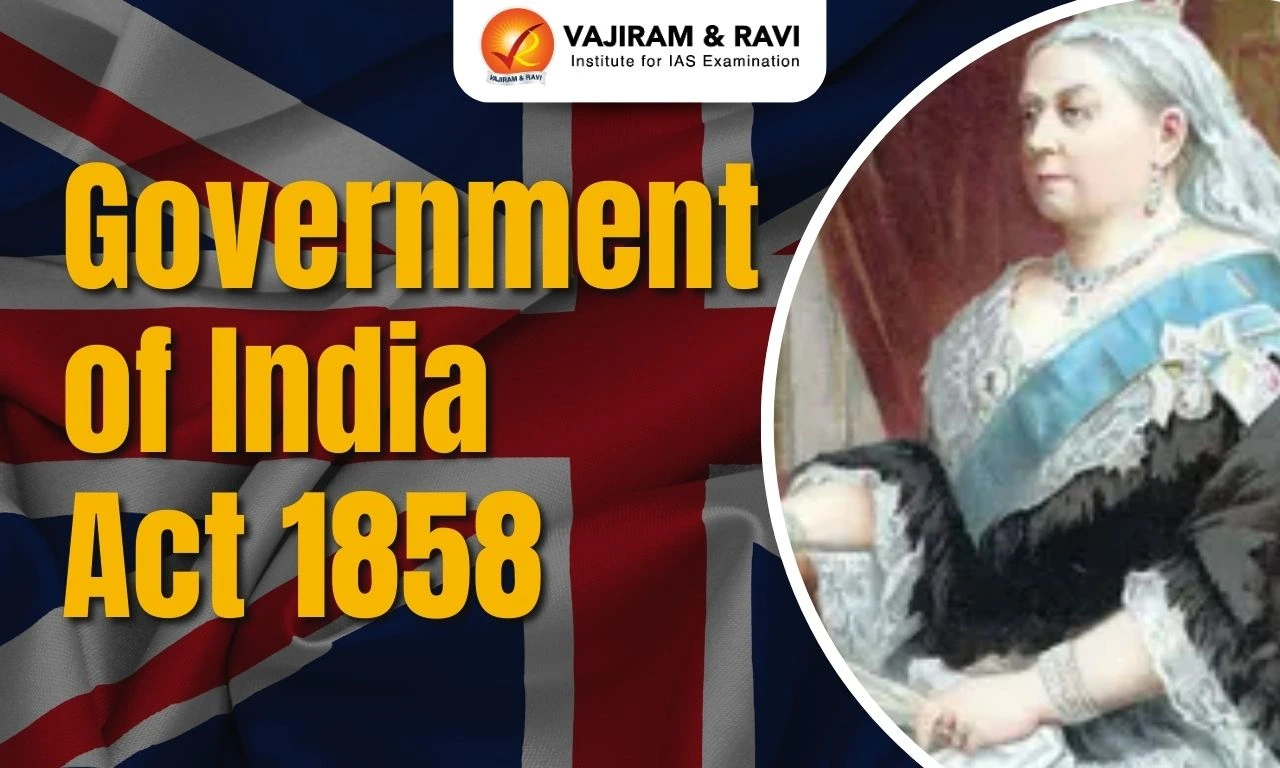The Government of India Act of 1858, also known as the Act for the Better Government of India, was a landmark piece of legislation passed by the British Parliament that marked a significant shift in Indian governance. It effectively ended the British East India Company’s rule over India and transferred administration to the British Crown.
The Government of India Act of 1858 established the British Raj, which lasted until India’s independence in 1947. The Act was a response to the Indian Rebellion of 1857, recognising the need for a more direct and centralised form of government.
What is the Government of India Act 1858?
The Government of India Act 1858, passed by the British Parliament on August 2, 1858, transferred authority over India from the East India Company to the British Crown. This shift was proposed due to flaws in the existing governance system, initially by Prime Minister Lord Palmerston. After Palmerston’s resignation, Edward Stanley introduced the revised bill titled “An Act for the Better Governance of India.” With this act, the British government took direct control over India, replacing the Company’s rule with a new administrative framework designed to improve governance.
Government of India Act 1858 Background
The Government of India Act 1858 is deeply rooted in the political, economic, and social unrest that sparked the Revolt of 1857. The East India Company, which had been administering India since the mid-18th century, was heavily criticised for its policies, which were perceived as exploitative and oppressive.
- The Revolt of 1857, also known as the First War of Indian Independence, exposed the weaknesses of the Company’s rule and demonstrated the need for a more direct and centralised form of governance.
- In response to the revolt and the realisation that the Company was incapable of effectively managing the administration, the British government decided to take direct control of Indian territories.
- The British Parliament passed the Government of India Act in 1858, also known as the Act for Better Government of India. This act was a watershed moment, reflecting the British determination to restructure Indian governance and prevent similar widespread uprisings from occurring in the future.
Queen Victoria’s Proclamation of 1858
Queen Victoria’s Proclamation of 1858 marked the transfer of power in India from the British East India Company to the British Crown. The proclamation, issued on November 1, 1858, sought to establish direct governance by the British monarch and ensured the British Crown’s sovereignty over India.
- It promised to respect Indian princes’ rights, avoid interference in religious matters, and abolish the Doctrine of Lapse.
- The proclamation aimed to stabilise British rule following the 1857 rebellion by ensuring the protection of Indian states and granting Indian subjects equal rights under British law.
Government of India Act 1858 Provisions
The Government of India Act of 1858 was enacted following the Revolt of 1857. The Act for the Good Government of India abolished the East India Company and introduced several key provisions to reorganise the governance of India:
- Transfer of Power: The Government of India Act of 1858 transferred the East India Company’s powers, territories, and revenues to the British Crown, effectively ending the Company’s rule in India.
- The act vested the British Crown with direct control over the Indian territories, with the monarch represented by the Governor-General of India.
- The Governor-General was also given the title of Viceroy, reflecting the Crown’s direct authority.
- Establishment of Secretary of State for India: The Government of India Act of 1858 established the position of Secretary of State for India, a member of the British Cabinet in charge of Indian affairs.
- A 15-member Council of India was also formed to assist the Secretary of State. The initiative and final decision were to be with the Secretary of State, and the council was to be advisory.
- He was also the point of contact between the British government in Britain and the Indian administration. He also had the authority to send secret communications to India without consulting his council.
- Governor-General and Viceroy: The Governor-General of India was appointed Viceroy, acting as the Crown’s representative in India. Lord Canning became the first Viceroy under the new system.
- Abolishment of Dual Government: The Government of India Act of 1858 abolished the Board of Control and the Court of Directors, effectively ending the double government system.
- Reorganisation of Indian Civil Services: The Government of India Act 1858 established the Indian Civil Services (ICS), which were open to Indians via competitive examinations.
- Expansion of Legislative Councils: The Government of India Act 1858 expanded the powers of legislative councils. It enabled the establishment of legislative councils at the provincial level, where laws could be enacted, amended, or repealed. These councils consisted of both official and non-official members.
- However, Indian representation was limited and did not accurately reflect the Indian population. The majority of the members were British officials.
- Military Reforms: The Act of 1858 brought the Indian Army under the direct control of the British Crown, with the Commander-in-Chief of India being subordinate to the Governor-General.
- Princely States: It was decided that the remaining Indian princes and chiefs (over 560 in number) would retain their independence as long as they accepted British rule.
Government of India Act 1858 Significance
The Government of India Act 1858 was crucial in reshaping India’s governance and transitioning power from the East India Company to the British Crown. The Act was significant for several reasons:
- Direct Rule of British: The Government of India Act of 1858 centralised India’s administration, placing it directly under the control of the British Government. This marked the start of the British Raj, a period of direct colonial rule that continued until 1947.
- End of Company Rule: The Government of India Act 1858 ended the rule of the East India Company, which had served as the primary agent of British imperialism in India for over a century. This shift marked a significant reorganisation of colonial governance.
- This Act also abolished the dual governance system envisioned by Pitt’s India Act of 1784, declaring India a direct British colony.
- Foundation for Future Reforms: The Government of India Act of 1858 paved the way for future legislative reforms in India, including the subsequent Government of India Act of 1935, which increased Indian representation in government.
Government of India Act 1858 Limitations
While the Government of India Act 1858 introduced significant changes in India’s governance, it had notable limitations that hindered meaningful Indian participation and maintained the colonial power structure.
- Lack of Indian Representation: The Government of India Act 1858 did not provide for any meaningful representation of Indians in the new administrative structures. The governance of India remained firmly in British hands, with little input from Indian leaders.
- Centralisation of Power: The Government of India Act of 1858 centralised power within the British government, reducing the autonomy of Indian provinces and restricting their capacity for self-governance.
- Continuation of Colonial Exploitation: While the Government of India Act of 1858 reorganised the administration, it did not address the root causes of the Revolt of 1857, which were economic exploitation and social inequality. The British Crown maintained policies favouring imperial interests over the welfare of the Indian people.
- Failed Reforms: The Government of India Act of 1858 failed to create a comprehensive constitutional framework for India, resulting in ambiguous legal and administrative guidelines.
- For example, the act instituted some reforms in the Indian Civil Services, but it did not significantly increase opportunities for Indians to advance to higher administrative positions.
The Government of India Act of 1858 marked a pivotal shift to direct British rule in India, centralizing power under the Crown and introducing major administrative reforms. However, it failed to address critical issues like Indian representation and ongoing colonial exploitation. Despite its limitations, the act established the British Raj, laying the groundwork for future reforms and, ultimately, Indian independence.
Government of India Act 1858 UPSC PYQs
Question 1: What was/were the object/objects of Queen Victoria’s Proclamation (1858)?
- To disclaim any intention to annex Indian States
- To place the Indian administration under the British Crown
- To regulate East India Company’s trade with India
Select the correct answer using the code given below.
(a) 1 and 2 only
(b) 2 only
(c) 1 and 3 only
(d) 1, 2 and 3
Ans: (a)
Last updated on April, 2025
→ UPSC Notification 2025 was released on 22nd January 2025.
→ The UPSC Vacancy 2025 were released 1129, out of which 979 were for UPSC CSE and remaining 150 are for UPSC IFoS.
→ UPSC Admit Card 2025 is expected to release in first week of May for CSE Prelims Exam 2025.
→ The UPSC Prelims 2025 is scheduled to be conducted on 25th May 2025 and UPSC Mains 2025 will be conducted on 22nd August 2025.
→ Apply once through it and aspirants can apply for various government exams conducted by UPSC.
→ The UPSC Selection Process is of 3 stages-Prelims, Mains and Interview.
→ UPSC Result 2024 is released with latest UPSC Marksheet 2024. Check Now!
→ UPSC Toppers List 2024 is released now. Shakti Dubey is UPSC AIR 1 2024 Topper.
→ Also check Best IAS Coaching in Delhi
Government of India Act 1858 FAQs
Q1. What was the Government of India Act 1858?+
Q2. What was the Magna Carta of India in 1858?+
Q3. Who became the first Viceroy of India under the Act of 1858?+
Q4. Which act is known as the Act for Good Government of India?+
Q5. What was the main point of the Government of India Act 1858?+
















